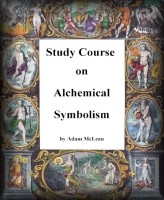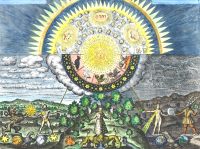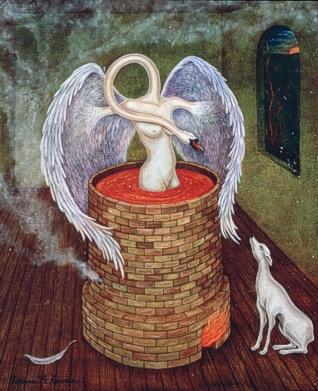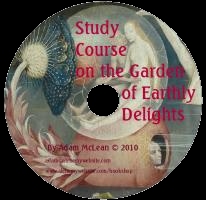|
|
Alchemy and depth psychologyBack to introduction.Although we can now recognise a psychological component in many alchemical texts, it is only since the early 20th century that a language was developed with which the newly emerging science of psychology could investigate, in depth, aspects of alchemical symbolism. There were some mid-nineteenth century attempts to work with the psychological elements in alchemical texts. A key work here was Mary Ann Atwood's Suggestive Enquiry into the Hermetic Mystery, published in 1850 and immediately withdrawn. Also E.A. Hitchcock in his Remark upon alchemy and the alchemists, 1857, takes an interior or more psychological view of the subject "My main proposition is that the subject of Alchemy was Man; while the object was the perfection of Man". Later the Theosophist's around Madame Blavatsky, and somewhat later, Rudolf Steiner, used alchemical ideas as way of looking at the internal structure of the human soul and spirit. One of the early pioneers of a psychological view of alchemy was Herbert Silberer (1882-1922), a member of the Vienna circle of psychotherapists. In his book Probleme der mystick und ihrer symbolik, 1914 (published in English initially with the title Problems of Mysticism and its symbolism, 1917), Silberer analysed the psychological components of the early 17th century 'Parabola' allegory, aspects of Rosicrucianism and the mystical writings of Jane Lead. Carl Jung (1875-1961) began to investigate the psychological components of alchemy in the 1920's and throughout the 30's 40's and 50's wrote a number of books interpreting alchemy within the context of his psychological ideas. In order to study the subject further, he began to collect a library of alchemical books. Jung's idea of the archetypes of the collective unconscious, resonated with the elaborate symbolic language of alchemical texts, and provided scholars with a new way to examine alchemical material. During the early 20th century the cultural climate, and the preconceptions of reductionist science, made it almost impossible for scholars to look at the ideas in alchemical texts, and the scholarship of this period merely presented alchemy as a historical phenomenon, a precursor of chemistry. Alchemy was at that time only investigated by occultists and historians of science. Jung's courage in grasping this difficult material and providing ways in which one could penetrate alchemical ideas without losing scholarly credibility, led to a serious reappraisal of alchemy which continues to this day. The most accessible of Jung's alchemical books must be Psychology and Alchemy (1944), which was derived from his Eranos lectures given in 1935-36. In this he first deals with dream symbolism and the imagery of alchemical material, and presented the picture that alchemy is a sea of collective archetypal images which can still surface in our dreams. In the second half of this book, Jung examines the religious ideas that were drawn into alchemy, and the subtle ways in which the alchemical tradition struggled with the contradictions and problems arising from religious ideas. For example, he looks in depth at the parallels between the philosophers' stone and the Christian mythos, the 'Lapis-Christ parallel', as he titled one of his chapters. Psychology and Alchemy is illustrated with 270 images from alchemical books and manuscripts and from related works. Many of these images were here presented in print for the first time, and this book had a profound influence and gave inspiration to many scholars and esotericists to re-examine alchemical symbolism. Jung's Alchemical Studies, is a series of essays on the 'Secret of the Golden Flower', Zosimos, Paracelsus, the spirit of Mercurius, and the tree as an archetypal symbol in alchemy. In these essays he is able to look in depth at particular aspects of alchemy. Probably one of the most difficult, and yet most influential of his books is the Mysterium Coniunctionis, 1955. Here he examines the nature of the opposites in the human psyche and the alchemical tradition. The uniting of the alchemical King and Queen, the male and female components of the psyche, is exhaustively investigated though various alchemical ideas, symbols and source texts. This book, which few people can have studied in depth, nevertheless, provided key ideas for understanding the complexities of alchemical symbolism. Jung certainly inspired others to investigate alchemy. His colleague Marie-Louise von Franz produced a series of important works analysing alchemy, 'Aurora consurgens', 'The Grail legend', 'Introduction to the Symbolism and Psychology of Alchemy', 'Alchemical active imagination', among others. L. Fierz-David wrote on the symbolism of the Hypnerotomachia, Jolande Jacobi edited a selection of writings of Paracelsus, and, more recently, Jungian influenced scholars such as June Singer, Charles Ponce, James Hillman, Henry Corbin, and many others have continued to explore alchemical ideas.
|
Introduction Reading list Some quotations Frequently asked questions Common misconceptions Timeline The different ways of looking at alchemy -------
Proto-chemistrySymbolism Psychology allegorical journeys mysticism metaphysical historians of ideas  Study Courses
Study Courses Alchemical, astrological and emblematic art prints  Alchemy and art  Art books Series  Study course on Bosch's Garden of Earthly Delights New Hieronymus Bosch Website |